Steven Spielberg‘s The Fabelmans is one of the stalwart director’s most personal films, given that it was based on his own childhood in New Jersey and Phoenix before his family finally moved out to California. The coming-of-age movie has received quite a bit of acclaim since it premiered at the Toronto International Film Festival, and the kudos continued this past week with a pair of Golden Globe wins as well as award nominations from both the DGA and SAG.
There are many great performances in The Fabelmans, but just as important are the various locations from Spielberg’s own childhood that had to be recreated from photographs and the filmmaker’s memory. That fell to Production Designer Rick Carter, a two-time Oscar winner who is among Spielberg’s longest collaborators (along with Composer John Williams), having served as both an Art Director and Production Designer on the director’s TV series Amazing Stories back in the ’80s.
Carter also designed the two Back to the Future sequels for Robert Zemeckis before Spielberg brought onto the original Jurassic Park movie that was released to huge box office numbers in 1993. He then returned to Zemeckis’ side for Forrest Gump, for which he received his first Oscar nomination, before winning his first Oscar for designing James Cameron‘s Avatar in 2009. Carter would win his second Oscar for his work on Spielberg’s Lincoln, and after a foray into the world of Star Wars, designing. both of J.J. Abrams‘ movies, Carter reunited with Spielberg for The Fabelmans.
Below the Line recently jumped on Zoom with Rick Carter, who told a fun story of how the Fabelmans production crossed paths with another awards player, Damien Chazelle‘s Babylon, and also discussed his involvement in the Jurassic World trilogy, which Spielberg executive produced.
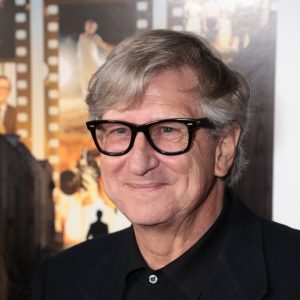
Below the Line: You’ve been working with Steven Spielberg for quite some time, both as a production designer and an art director. Was there any point over the last 37 years that he mentioned he might want to make a movie about his own childhood, or a time when you were working on something, and he said, ‘This reminds me of when I was in high school…’?
Rick Carter: I have had numerous conversations with him over the years. Since we’re not that far apart [age-wise] — only three years — lots of points of reference would emerge where little stories would come up. Since you’re asking me that question, it makes me think of this, in this context, which is when I was on Amazing Stories and I was asked to do some art direction for an additional scene that was shot for Empire of the Sun, [which] Norman Reynolds designed.
We went out to Bakersfield and there was a little twister that came up over the hill. It looked like a little tornado. It was not something I’ve seen very often, but you start to see everything swirl around. It actually moved right down through the set. It wasn’t huge, but it was 20 feet tall or something like that. Everybody was battening down, holding onto things, and moving away from it, and Steven ran and chased after it to get into the middle of it. I didn’t know what that referenced, but then, years later, a little before this movie I had known about his mother collecting the family and getting them to go and chase after a tornado that came through where he was growing up. That’s the scene that’s depicted in the movie. I think it’s contextualized in a very dramatic moment, condensing the drama of what’s happening in their lives to, in a sense, be the tornado that’s in her. I had seen him actually do this years before, so there he was, as if he was drawn to a tornado himself. He would reference things along the way. The bullying in school, for the most part, was the thing I had heard stories about.
BTL: So you’re saying we could have lost Steven Spielberg in the ’80s from him chasing after a twister?
Carter: No… [maybe] if it had been a big one and he’d been that crazy… but in this case, I think he just wanted to be in the midst of a windstorm that would help him recall the craziness of that part of his youth.
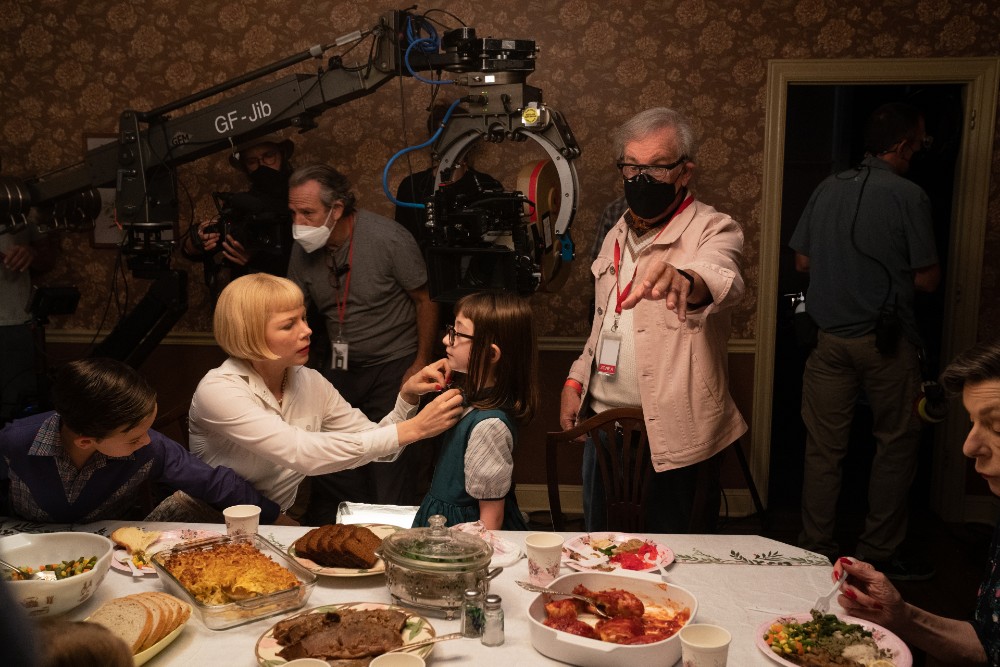
BTL: At what point did all of these stories start to turn into a screenplay — Steven’s first writing credit since A.I., and one he shares with Tony Kushner? Did they start writing during the pandemic?
Carter: I think everything you’ve said, is what he said to me when he gave me the script, which was in January two years ago, because everything had just shut down. He actually was thinking, “Is this going to come back? What movies would matter to me the most to make if that’s really the case?” I think that helped prioritize that this was a movie he’d been thinking about for a long time and had scenes from, but I think it made him realize the time was then to focus on it.
Tony was interested in exploring it with him, so they went back and forth, and just as they’ve said, they just made it into a routine to have something to do that was like business, that was safe, both because of the pandemic, but also a place to kind of explore. Tony is such a strong dramatist that you see his ability to ferret out the storyline, and what really would be something that if you would tell it about yourself, you might keep certain things away.
But then, if you’re in association with someone who’s as insightful as Tony is, he would dig further into, “Well, what happened there? What do you think was going on there? And then, that would associate [with] this, and what if you combine those two, even if they happened separately in time? In a movie, you could bring those together, and they would form the basis of a scene that would then be very potent.”
I think that dramatic fable-izing of the story is where the freedom came for Steven to, not only just recollect what was, but from a balanced position, also, because his parents had passed away. They were both very friendly with each other throughout their lives. For instance, both their spouses, his parents’ husband and wife, passed away way before they did. They lived to be old. Leah, who was Mitzy, was 98, and Arnold, who was Burt, was 103. They would come together to all these celebrations that Steven would have, for various awards. I think it was an opportunity finally to, in a sense, see them for who they were [and] what the impact had been, but without rancor and weird things. He got together with his sisters too, so it was very much a family experience that they had. But it takes a lot of years to get to that point, which is, I think, what’s reflected in the movie. That’s what I think he enjoyed doing — that gave him the reason to make the movie right after the pandemic. [It] was important to him.
BTL: Was their screenplay very descriptive about the locations, whether it be any of the Fabelmans’ houses or Sammy’s school? Or did you start researching that kind of stuff after you read the script?
Carter: Yeah, it’s not in the script. At least two of the main three houses were based upon real places, particularly the middle one, the Phoenix house. Not only do we have pictures of what the outside looked like — and still does, because they haven’t torn [it] down — but we had a floor plan that he drew for us of what was on the inside. That way, we know, like, if you walk into the New Jersey house, on the right side will be the living room, the left side will be the dining room, and the kitchen behind that, and the stairway in the middle. Those kinds of things were helpful, because that way, whatever was written, we knew would line up geographically with what we were putting as the architecture. Otherwise, you have to ask those questions, and in this case, we pretty much knew, based on his little sketches, where things would be.
And then it was about the detailing, and getting further and further into either what he remembered or his sisters remembered, or just what we wanted to express artistically. Because we were making the fable version — we weren’t just recreating something. First of all, we didn’t have all the information anyway, but also, just the color palette in the New Jersey house of having complementary colors between the green side on one side of the house and the warm colors on the other side. It just became [a] way of almost demarcating territory within the house or in the desert house, having it look like the desert colors even on the inside. These are things that are very subtle, and they’re just ways of making each part of the movie look differently [and] have a different feel to it in terms of the environment.
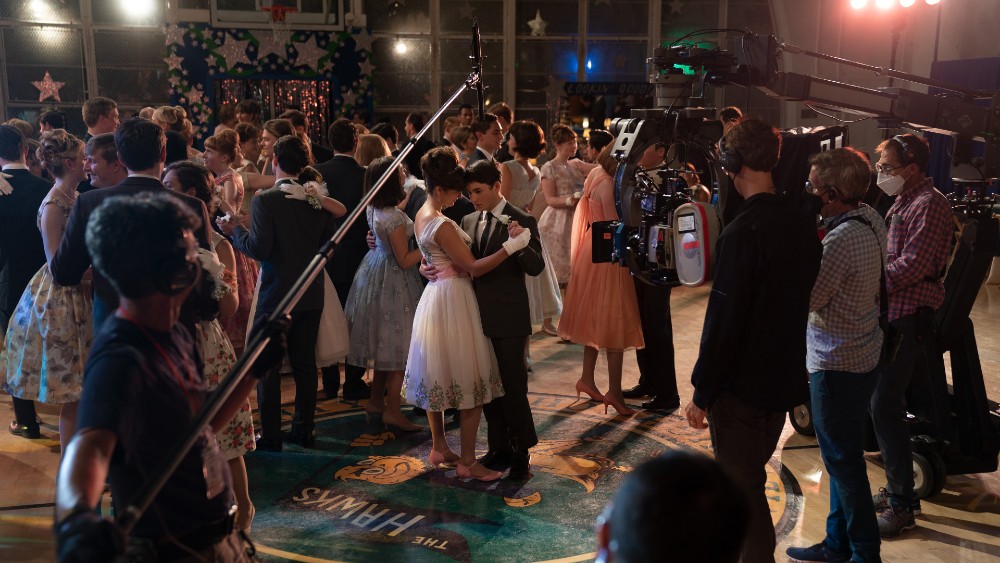
BTL: Were you able to go to any of those existing houses to walk around inside?
Carter: No, we didn’t, first of all, because the pandemic was [still] raging, but we had photos. There was literally a Life Magazine spread on where Steven grew up that we could access. We could also go on Google and see what it looked like, and then Steven would say, ‘It didn’t look like that exactly. It was more like this.’ Then, we’d have a picture that might have something in it that he could say, ‘See the way that paneling is in that one corner of the picture? That’s what the whole thing.’ It was that kind of thing. We got to reference [everything] in a cryptic way, but having those pieces [wasn’t] just [about] the technical part, they were the memory part, and that would be the element we would want to put in if we could so that when Steven was in the space, he would feel like it was resonating with his own past, but wasn’t limited to that.
BTL: That has to be the toughest reference, going by someone’s memory, because something could happen today, and by tomorrow, three different people will have a different memory about what really happened.
Carter: Along those lines, imagine that it’s not only Steven, but he has three sisters, who all have [their own] reference, because he wanted to include them in the process. They’re wonderful people, and they all get along, but they still have different memories. They would bring the details that they remembered, and Karen O’Hara, the Set Decorator, in particular, went to great lengths, with Andy Siegel, the Prop Master, to make sure that all the things that we could do that were referenced by them would appear on the set so that they could actually have a sense of that throughline to their own past.
And then, Steven asked me to show the set to [all three] sisters before he even saw it. I really didn’t know what to make of that. I knew he would like it, and I thought they’d like it, but still, it was great that they did because, for an art director or a production designer, there’s always the thing [where] you’ve got not only the director, you might have the director’s wife or husband, or someone else who has an opinion — it can be a studio executive, too — but in this case, it was people [who] actually lived the memory, or their version of it, like you said.
BTL: Did you end up filming the entire movie in L.A. or did you do some exteriors in the real places?
Carter: No, we did it all in L.A. There are two traveling shots that were done in Arizona, as a second unit, with cacti. Other than that, it was all done in [the] L.A. vicinity, for the most part. There’s a little up in Santa Ynez for the wine country, but [it was] all based here. We did it very much like… my thought was, ‘Let’s make it, both for budget reasons and for what we’re dealing with [in terms of] the pandemic, like Sammy Fabelman would have [had he] been given the opportunity to make his movie in the ’70s.’
Having worked in Los Angeles in the ’70s at Universal, like Steven, I know what that is. Everything’s out in the 30-mile zone, basically. We made sure that we made that the dictum that we all had to live with and make it work, because that way it would have a leanness to it and an authenticity, actually, to the way, he maybe would have made his movie in the ’70s when he first came to town. It’s not so much just “a movie by Steven Spielberg,” which, of course, it is, but it’s also the movie — maybe — that Sammy could have made.
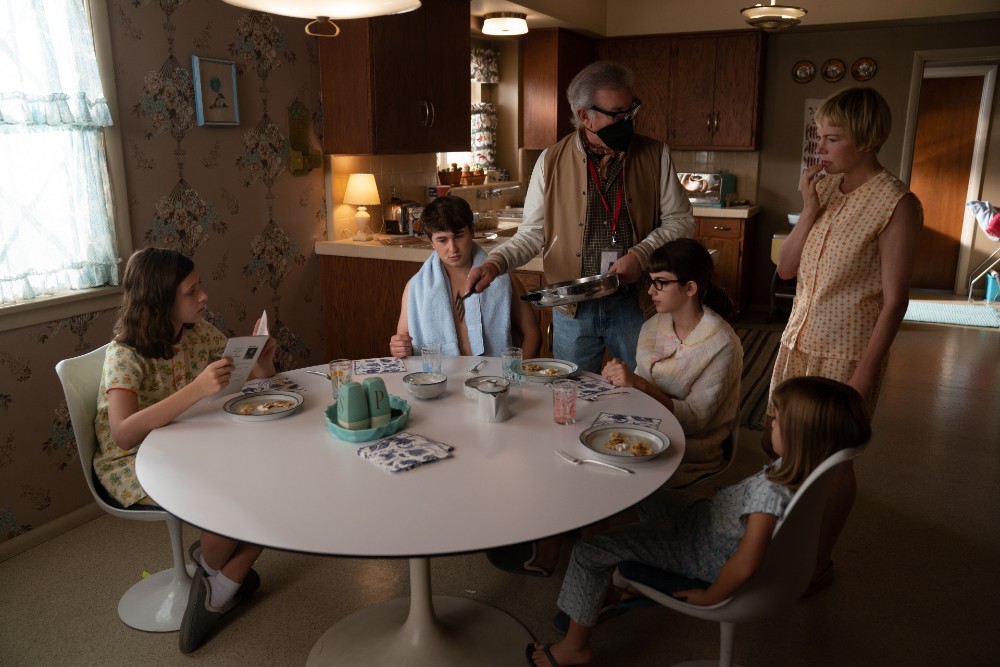
BTL: Did you end up building some of the house exteriors as well, since there’s so much that happens outside the houses, or did you just find places that looked like them?
Carter: We found places that looked like them, but we did a lot of work on the Phoenix house, where we clad the whole exterior with some wood paneling to look like what his actual house had looked like in Phoenix. It was more of a house that had just been created, and that was the style. Since that time, it’s been covered over, the real house, and we couldn’t find any other houses that looked just like it. We found the right context of a house that looked approximately like his did, and then we worked on the exterior. We painted the New Jersey house, a location. The exteriors had the least amount of work, other than the Phoenix house, compared to the interiors, which were all built on stage.
BTL: Is his high school still standing, and is it still a high school?
Carter: We went and visited it, and then we just ended up going to Dorsey High in Los Angeles, just because it’s of the era, and also, it has a style that looked like it could be in Northern California. It sort of hit both marks, and also had a good color palette and a great gym. [chuckles]
BTL: I assume that last bit at the Paramount lot wasn’t hard to do, since he has made so many movies for Paramount that he could just say, “I need to shoot something there, is that okay?” Was it that easy or not?
Carter: It’s not that easy, but because it was him, they allowed us to do it. We wanted a period lot, and that would really fit the bill the best. And then, Babylon was shooting. They actually were shooting exteriors on the lot, scheduled on the same day, so we had to work out how we were looking one way, and they were looking at another. Of course, they could have said “no,” because they’re a Paramount picture and everything, but Damien and their crew were very gracious. We were only there for literally three hours, just to pop off that shot at the end of the day.
BTL: I can’t imagine Damien would have said “no” if it was up to him.
Carter: Everybody was very gracious with one another. It was very easy, actually, and Paramount wanted it to happen.
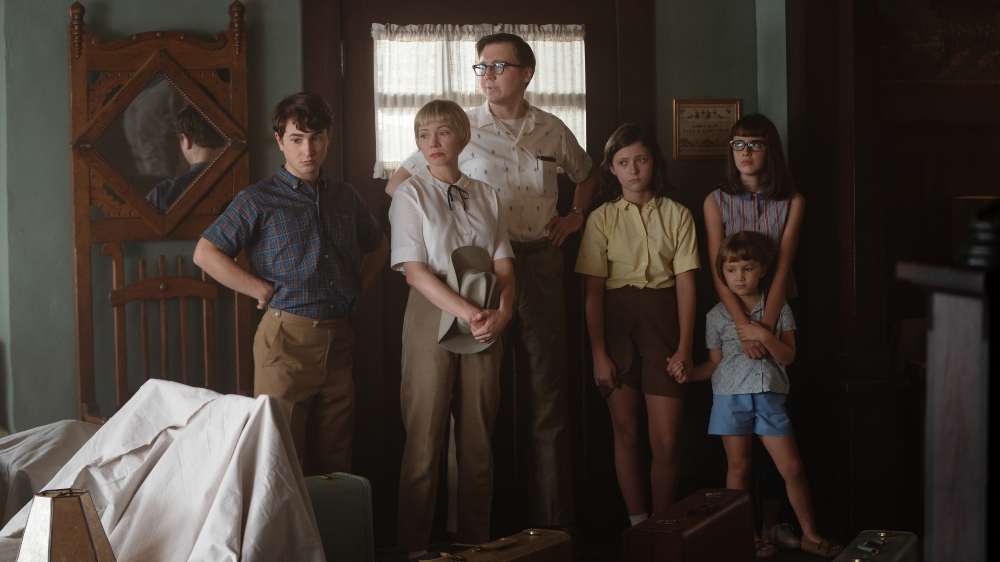
BTL: I tend to watch movies very carefully for things like production design and locations, and it always amuses me — though I’m sure it doesn’t amuse you as a production designer — when there’s this amazing set, which literally ends up being used in a single scene. For The Fabelmans, I think the early scene with the young Sammy being taken to the theater had to be one of those, so what was involved with getting that shot?
Carter: That was the appropriate amount of time for it to be in the movie. We’re scheduling everything quite tightly, so we had to do an exterior and an interior, and then there were some driving shots, all on the same day. Just to go there for a short period of time, it was just the right thing. You’re right [that] if you do a whole lot of work, and then it doesn’t show up in the movie, that can be frustrating. I’ve learned to be pretty… I guess the word would be, almost, “Buddhist” about it. The impermanence of the work, because you do so much, especially if you build a whole set, and then they come in, even if they shoot it all, [and] when it’s gone, you just can’t believe that all that work went in and then it’s just been dismantled and [it’s] gone.
I don’t hold on too much anymore, and I think probably the digital side of things has helped with that, because sometimes there’s so much that’s digital, it never was there to begin with. [chuckles] But being old-school as I am, I do love the work that we get to do, because the craftsmanship that goes into some of these recreations, whether it’s an interior set or something that’s on the exterior that’s created, it’s magical. It never ceases to amaze me, and of course, I like having the record of it in the movie, but the doing of it is actually where my real memory of it usually is.
BTL: Maybe Universal could put “Sammy Fabelman’s childhood home” on the Universal lot.
Carter: They still have the War of the Worlds wreckage, and it’s not even a Universal movie.
BTL: For my last question, I’m going to channel my inner fanboy. I noticed that you had earned a credit for “visual concept art” on the Jurassic World movies. I know you designed the original Jurassic Park, so did Colin Trevorrow bring you in because he wanted Jurassic World to line up with the visuals of Jurassic Park? How did you get involved in that?
Carter: I was called in by Frank Marshall, the Producer, as the first person to come in and just start playing with ideas, based upon an early script, as to how the sequel might go. Then Colin came in, and we hit it off, so I just stayed around as a segue between what we had done on the first two movies, and then we brought on the Production Designer of the third one, Ed Verreaux, who I’d worked with before, and segued into him being a production designer. I was kind of there to help it move from the Park that it had been into, ‘what could this new Jurassic World be?’ and inspire the throughline as far as I could, and then let it be taken over by Colin and their teams.
It was a four-month period of transition that I got to work when there was very little there, and then [imagine], ‘what could it be?’ Ask those types of questions, and then, when Colin started to make it his own and bring so much to it, it was great because he was such an amazing student and created in relation to what had been done. It was a great dialogue right from the beginning. I brought them not only the first Jurassic World designer in, but I brought the third one in, Kevin Jenkins, because he was the co-designer I’d worked with [and] brought up as an illustrator, and he became a designer on Jurassic World [Dominion].
The Fabelmans is still playing in select theaters, and available to buy or rent on all major digital/VOD platforms. The film arrives on Blu-ray and DVD on Feb. 14.





